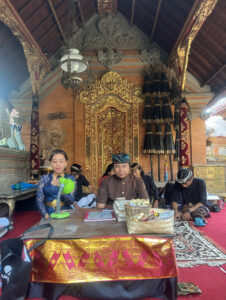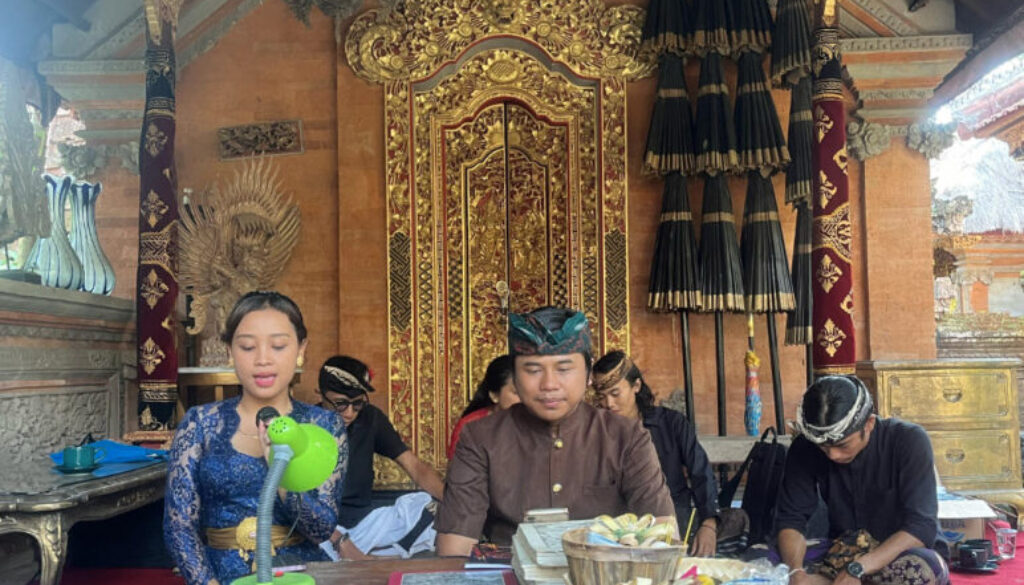Polyphonic Reading of Palm-Leaf Manuscripts in Lombok

Nowadays, we think of writing as something that appears on paper, or a screen (or a billboard), and something we read/consume individually, but this is a very recent idea. Venture back a few centuries, or out among the endangered alphabets, and writing is part of a performance–such a fascinating difference that it’s the subject of my next Writing Beyond Writing Book Club meeting, on August 25th.
A perfect illustration of the difference between the two understandings of reading, and of writing, was sent to me a couple of days ago by Peter Austin (recently retired from the world-famous School of Oriental and African Studies in London), namely a link to an article he wrote for Language Documentation and Description about the public reading of lontar or palm-leaf manuscripts by the Sasak people on the island of Lombok in Indonesia. Though as you will see, what they mean by “reading” is very different from what we mean.
Lombok is a neighbor of Bali, and like the Balinese, the Javanese, and many other cultures of the region, the Sasaks have a long literary tradition, some two centuries old, of inscribing texts on the dried leaves of the lontar palm, using a script closely modeled on the Balinese. Here’s the point, though: not only these texts, but writing itself, are seen as sacred. The lontar manuscripts, which include histories, traditional folk tales, poems, songs and incantations, are ceremonially read in performances called pepaòsan at ceremonies such as circumcision, funerals and weddings, and in rural areas as part of a process to ensure fertility of cows, horses and water buffalo.
(Similar public readings take place on the islands of Flores, during circumcision ceremonies, and Bali, where they take place within a Hindu context rather than an Islamic one.)
One challenge it faces is that the word “reading” means something very different and far more skilled and demanding in Lombok than it does elsewhere.
“According to my consultants,” Peter Austin writes, “learning how to perform lontar readings takes place in a series of steps. Texts are studied in small groups with a reader who knows how to perform [them according to tradition]. The students first repeatedly copy out the script of the text without being able to read or understand it. Next, the teacher recites the text with the correct rhythm and intonation, and finally the interpretation and context of the text is imparted. Learning to read in this fashion can take several months or more.”
It’s not simply learning to read the text out loud correctly. The pepaòsan are, in fact, polyphonic, involving at least two readers, the audience, and music.
Austin writes of one pepaòsan he attended:
“The performance began in the evening at around 7pm at a specially constructed covered location in the hamlet and involved three main readers and an audience of perhaps 100, all male. After eating a meal and reciting prayers, the performers took their places in the centre of the pepaòsan area on mats, surrounded by the audience.…
“Paper copies of lontar were used, rather than palm leaf manuscripts, and they were placed on decorated pillows in front of the readers, along with a container of betel nut and associated lime and leaves.
“The performance began with one reader addressing the audience in a mixture of high Sasak and Kawi [a form of literary Javanese], inviting them to listen to the performance and apologising for any errors or mistakes. Then a number of lontar texts were read…by two readers, who act in alternation. One reader (called pemaòs) recited one or two lines of the Kawi and/or Sasak text with the appropriate melody, and a second reader (called pujangge) provided an interpretation of the lines into contemporary Sasak. A third reader (or the audience) joined the pemaòs to recite the last few words (with their melody of each section). The performance was thus polyphonic, requiring the active participation throughout of the pemaòs, the pujangge and the audience. Text readings such as this take many hours and it is not uncommon for performances to continue until 1am or later, as this one did.”
As I said, this remarkable performance tradition seems significantly endangered. Peter Austin estimated in 2010 that the number of skilled readers numbered no more than a hundred, and texts in Arabic or Malay were now often being used on these ceremonial occasions.“Without a reader, the text cannot be learned or performed, even if a copy of the manuscript exists,” he points out, but even the existence of manuscripts is under threat. Old customs in general are being eradicated, and the relatively few surviving palm-leaf manuscripts are being sold to tourists visiting the island, and on Bali.
This post is sponsored by our friends at Typotheque.


